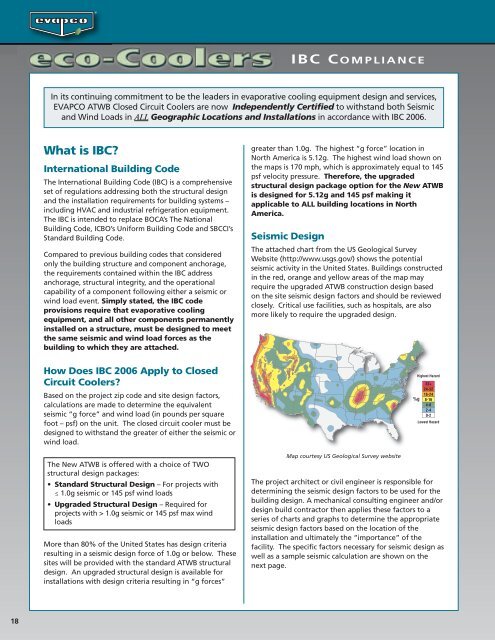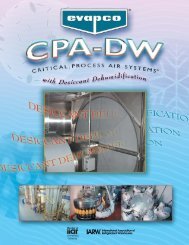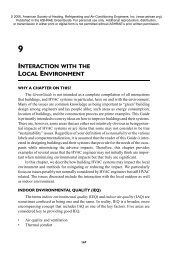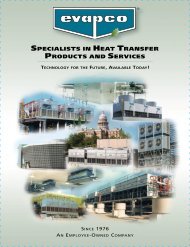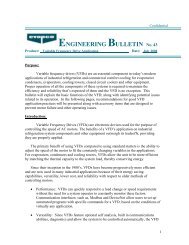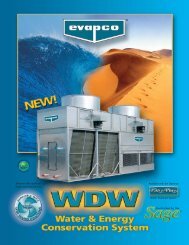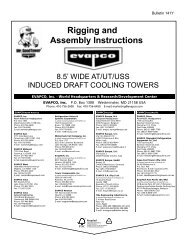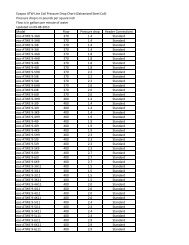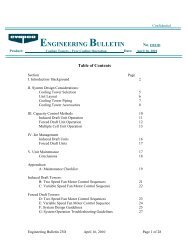eco-ATWB Marketing - Evapco
eco-ATWB Marketing - Evapco
eco-ATWB Marketing - Evapco
Create successful ePaper yourself
Turn your PDF publications into a flip-book with our unique Google optimized e-Paper software.
IBC COMPLIANCE<br />
In its continuing commitment to be the leaders in evaporative cooling equipment design and services,<br />
EVAPCO <strong>ATWB</strong> Closed Circuit Coolers are now Independently Certified to withstand both Seismic<br />
and Wind Loads in ALL Geographic Locations and Installations in accordance with IBC 2006.<br />
What is IBC?<br />
International Building Code<br />
The International Building Code (IBC) is a comprehensive<br />
set of regulations addressing both the structural design<br />
and the installation requirements for building systems –<br />
including HVAC and industrial refrigeration equipment.<br />
The IBC is intended to replace BOCA’s The National<br />
Building Code, ICBO’s Uniform Building Code and SBCCI’s<br />
Standard Building Code.<br />
Compared to previous building codes that considered<br />
only the building structure and component anchorage,<br />
the requirements contained within the IBC address<br />
anchorage, structural integrity, and the operational<br />
capability of a component following either a seismic or<br />
wind load event. Simply stated, the IBC code<br />
provisions require that evaporative cooling<br />
equipment, and all other components permanently<br />
installed on a structure, must be designed to meet<br />
the same seismic and wind load forces as the<br />
building to which they are attached.<br />
How Does IBC 2006 Apply to Closed<br />
Circuit Coolers?<br />
Based on the project zip code and site design factors,<br />
calculations are made to determine the equivalent<br />
seismic “g force” and wind load (in pounds per square<br />
foot – psf) on the unit. The closed circuit cooler must be<br />
designed to withstand the greater of either the seismic or<br />
wind load.<br />
The New <strong>ATWB</strong> is offered with a choice of TWO<br />
structural design packages:<br />
• Standard Structural Design – For projects with<br />
≤ 1.0g seismic or 145 psf wind loads<br />
• Upgraded Structural Design – Required for<br />
projects with > 1.0g seismic or 145 psf max wind<br />
loads<br />
More than 80% of the United States has design criteria<br />
resulting in a seismic design force of 1.0g or below. These<br />
sites will be provided with the standard <strong>ATWB</strong> structural<br />
design. An upgraded structural design is available for<br />
installations with design criteria resulting in “g forces”<br />
greater than 1.0g. The highest “g force” location in<br />
North America is 5.12g. The highest wind load shown on<br />
the maps is 170 mph, which is approximately equal to 145<br />
psf velocity pressure. Therefore, the upgraded<br />
structural design package option for the New <strong>ATWB</strong><br />
is designed for 5.12g and 145 psf making it<br />
applicable to ALL building locations in North<br />
America.<br />
Seismic Design<br />
The attached chart from the US Geological Survey<br />
Website (http://www.usgs.gov/) shows the potential<br />
seismic activity in the United States. Buildings constructed<br />
in the red, orange and yellow areas of the map may<br />
require the upgraded <strong>ATWB</strong> construction design based<br />
on the site seismic design factors and should be reviewed<br />
closely. Critical use facilities, such as hospitals, are also<br />
more likely to require the upgraded design.<br />
Map courtesy US Geological Survey website<br />
Highest Hazard<br />
32+<br />
24-32<br />
16-24<br />
%g 8-16<br />
4-8<br />
2-4<br />
0-2<br />
Lowest Hazard<br />
The project architect or civil engineer is responsible for<br />
determining the seismic design factors to be used for the<br />
building design. A mechanical consulting engineer and/or<br />
design build contractor then applies these factors to a<br />
series of charts and graphs to determine the appropriate<br />
seismic design factors based on the location of the<br />
installation and ultimately the “importance” of the<br />
facility. The specific factors necessary for seismic design as<br />
well as a sample seismic calculation are shown on the<br />
next page.<br />
18


